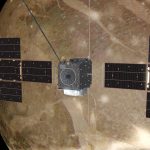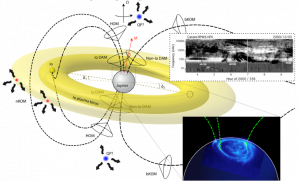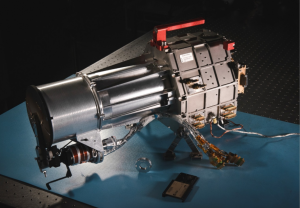
The JUICE magnetometer (J-MAG) : Onboard JUICE:
The JUpiter ICy moon Explorer (JUICE) is an ESA-led mission with strong involvement from Japan. The “ONBOARD JUICE” series looks at the instruments on JUICE for which Japan has contributed hardware or expertise. An introduction to the mission and instrument overview can be found [here].
Author: Matsuoka Ayako (Kyoto University), lead researcher for J-MAG-Japan
Quick fact sheet: J-MAG
The magnetometer (J-MAG) that measures magnetic fields is one of the core instruments on the JUICE spacecraft.
Firstly, J-MAG is expected to increase our understanding of the interior structure of the icy moons of Jupiter, specifically those of Ganymede, Callisto and Europa that are all thought to have liquid oceans underneath an icy crust. The Jupiter moon, Ganymede, is known to generate its own magnetic field, making it unique amongst the moons in our Solar System today. Neither Europa nor Callisto can generate their own magnetic field, but charged ions in the underwater oceans of all three icy moons respond to Jupiter’s engulfing magnetic field and create an induced magnetosphere. The depth of the moons’ subsurface oceans is related to the strength of the induced magnetic fields, allowing measurements performed by J-MAG to constrain how deep a hidden ocean resides beneath the moons’ icy crusts. The J-MAG team is therefore interested in the configuration of both the internal magnetic fields and the induced magnetic fields arising within the moons’ subsurface oceans.
Secondary, the magnetic fields that entwine around Jupiter drive the plasma processes within the Jupiter system. Magnetic field observations allow for a better interpretation of dynamical plasma processes, auroral phenomena and systems of electric current that drive through the Jovian magnetosphere.

The J-MAG magnetometer will measure the direct current (DC) magnetic field vector and magnitude (in the bandwidth DC to 64Hz) in the spacecraft vicinity. It is a conventional, dual sensor fluxgate configuration of mature design and considerable space flight heritage, combined with a Coupled Dark State Magnetometer (CDSM) that is an absolute scalar sensor based on more recently developed technology.
| Parameter | Requirement |
| Dynamic range (during science phase) | ±8,000 nT |
| Scalar sensor intrinsic accuracy | 0.2 nT |
| Fluxgate sensor orthogonality (calibrated) | 0.01o |
| Digital resolution | < 0.1 nT |
| Accuracy in-flight (calibrated) | 0.2 nT |
| Lifetime | 13.5 years |
J-MAG is located at the end of a 10.6 m boom and consists of three magnetometer sensors. Two sensors can measure the magnetic field’s orientation and direction, and one sensor can measure the strength of the field (SCA). The sensor furthest from the spacecraft is the outboard (MAGOBS) fluxgate sensor, and the sensor closer to the spacecraft body is the inboard (MAGIBS) fluxgate sensor. All three sensors connect via harness to an electronics box housed within the spacecraft body. The SCA is an optical sensor using the Zeeman effect in Rubidium gas to measure the absolute field. The Zeeman effect causes a spectral line (light at a particular wavelength) emitted by the Rubidium gas to split into multiple lines proportional to the strength of the magnetic field. The gas is excited to emit the spectral line using specially modulated light from a semiconductor laser through an optical fibre. The transmitted light is returned through a second fibre into the instrument electronics. The role of the SCA scalar sensor is to provide a reference measurement in order to calibrate the fluxgate sensors once the spacecraft goes into orbit around Ganymede.
Defined J-MAG science targets result in a requirement to determine accurate knowledge of the sensing orientation by two fluxgate sensors, MAGIBS and MAGOBS, on the spacecraft. Due to the long MAG boom it would not be easy to meet J-MAG’s alignment requirement by mechanical stability alone. To evaluate the alignment error of the sensing direction, the spacecraft includes two orthogonal (JACS) coils mounted around its body. The coils can be driven with a current which produces a measurable magnetic field vector at the fluxgate sensors. This signal can then be used by the fluxgates to track the variation in the sensor alignment.
The Japanese Selene (Kaguya) spacecraft also housed an on-board coil to generate artificial magnetic fields that were detected by the boom mounted fluxgate sensor and used to determine the sensor alignment. Japanese J-MAG members have worked on the application of the analysis technique developed for KAGUYA to the specific case of JUICE. They studied the feasibility to determine the relative alignments of the fluxgate sensors with respect to the JACS coils. After the launch they will work on the analysis of the magnetic field data during the JACS operation, and evaluate the sensor alignments and their variation. The results should significantly contribute to the final scientific objectives of the JUICE mission to reveal the structure of the ocean under the icy crust of Ganymede.
Further information:
The JUICE Mission: Japan joins ESA to head to the icy moons
J-MAG Fact Sheet
JUICE Japan website

 Previous Post
Previous Post Next Post
Next Post






